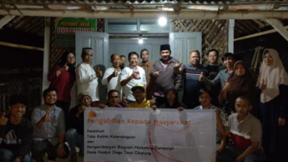Akselerasi Revitalisasi Proses Pemasaran Dage Desa Ciberung Menuju Economic Growth and Market Expansion
##plugins.themes.academic_pro.article.main##
Abstract
The dage commodity is the leading commodity in Ciberung Village, Ajibarang, Banyumas as the center of dage business and production. Dage itself is made from a mixture of coconut materials. Specifically for the Banyumas area, the dage produced is made from coconut pulp or cake, brown to gray in color, and covered with mushrooms. Currently, the dage production process is still spread among individual craftsmen. This condition has an impact on the uneven quality of the dage products produced. This results in several shortcomings starting from the aspect of product quality and scalability of dage products in the market. For this reason, the service to the dage craftsmen group in the Ciberung Village government environment was carried out to overcome these problems, and became a form of effort in developing the marketing of dage products, in order to produce superior products that have competitiveness and have the opportunity to expand the market. The training is in the form of developing a marketing campaign, and applying the concept of branding to develop this product. It is hoped that with this training Dage can be recognized by the wider community.
##plugins.themes.academic_pro.article.details##

This work is licensed under a Creative Commons Attribution-NonCommercial 4.0 International License.
JURPIKAT (Jurnal Pengabdian Kepada Masyarakat) accepts manuscripts that have not been published elsewhere and are not under consideration for publication by other print or electronic media. Authors retain copyright and grant the journal right of first publication with the work simultaneously licensed under a Creative Commons BY-NC License that allows others to share the work with an acknowledgment of the work's authorship and initial publication in this journal.
Authors are able to enter into separate, additional contractual arrangements for the non-exclusive distribution of the journal's published version of the work (eg, post it to an institutional repository, in a journal or publish it in a book), with an acknowledgment of its initial publication in this journal.
License to Publish
The non-commercial use of the article will be governed by the Attribution-NonCommercial 4.0 International (CC BY-NC 4.0). The author hereby grants JURPIKAT (Jurnal Pengabdian Kepada Masyarakat) an exclusive publishing and distribution license in the manuscript include tables, illustrations or other material submitted for publication as part of the manuscript (the “Articleâ€) in print, electronic and all other media (whether now known or later developed), in any form, in all languages, throughout the world, for the full term of copyright, and the right to license others to do the same, effective when the article is accepted for publication. This license includes the right to enforce the rights granted hereunder against third parties.
References
Badan POM. (2022). Dage, Makanan Tradisional yang Unik. Istana UMKM. https://istanaumkm.pom.go.id/id/galeri/dage-makanan-tradisional-yang-unik
Devita, C. (2016). Traditional Marketing Vsexperiential Marketing Manakah Strategi Pemasaran Yang Lebih Efektif Bagi Konsumen Dalam Pusat Perbelanjaan? Jurnal Manajemen, 1(2), 1–23.
Dewi, M., Hubeis, M., & Riani, E. (2020). Strategi Pemasaran UMKM Dalam Meningkatkan Daya Saing di Pasar Ritel Modern Carrefour (Kasus PT MadaniFood, Jakarta). MANAJEMEN IKM: Jurnal Manajemen Pengembangan Industri Kecil Menengah, 15(1), 77–83.
Indahingwati, A., Launtu, A., Tamsah, H., Firman, A., Putra, A. H. P. K., & Aswari, A. (2019). How digital technology driven millennial consumer behaviour in Indonesia. Journal of Distribution Science, 17(8), 25–34. https://doi.org/10.15722/jds.17.08.201908.25
Khaeruman, K., & Hanafiah, H. (2019). Perbandingan Kualitas Produk Sayur Dan Buah Pada Pasar Tradisional Dan Pasar Modern Di Kota Serang Dalam Penerapan Strategi Pamasaran. Majalah Ilmiah Bijak, 16(2), 110–120. https://doi.org/10.31334/bijak.v16i2.513
Kusumastuti, A. D. (2022). Strategi Peningkatan Penjualan Produk Melalui Pendekatan Unique Selling Point Dalam Menunjang Eksistensi Bisnis HNI HPAI. Jurakunman (Jurnal Akuntansi Dan Manajemen), 15(1), 31. https://doi.org/10.48042/jurakunman.v15i1.88
Maulana, Z., Chanif Hidayat, M., & Agustina, I. (2022). Using Digital Marketing for Small and Medium Enterprises (SMEs) in Bumdes Remboko Sumberrejo Village Sleman Regency. SPEKTA (Jurnal Pengabdian Kepada Masyarakat?: Teknologi Dan Aplikasi), 3(1), 31–38. https://doi.org/10.12928/spekta.v3i1.4563
Moncey, A. A., & Baskaran, K. (2020). Digital Marketing Analytics: Building Brand Awareness and Loyalty in UAE. 2020 IEEE International Conference on Technology Management, Operations and Decisions, ICTMOD 2020, 1–8. https://doi.org/10.1109/ICTMOD49425.2020.9380579
Purwatiningsih, S. D. (2021). Marketing Digital Campaign Dalam Membangun Startup Melalui Influencer Pada Masa Pandemi Covid-19. Ekspresi Dan Persepsi?: Jurnal Ilmu Komunikasi, 4(2), 146–156. https://doi.org/10.33822/jep.v4i2.2905

